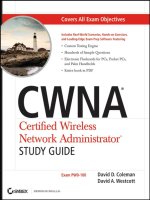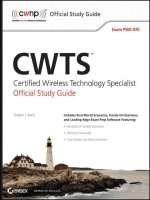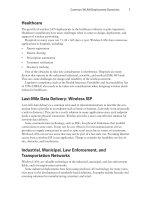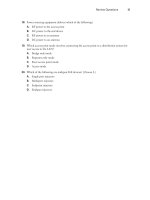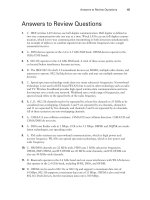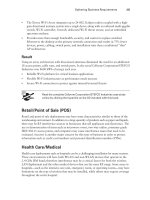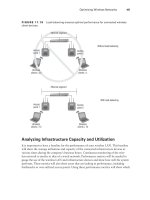Hacking ebook CompTIA cybersecurity analyst (CSA+) study guide exam CS0 001
Bạn đang xem bản rút gọn của tài liệu. Xem và tải ngay bản đầy đủ của tài liệu tại đây (27.82 MB, 819 trang )
www.hellodigi.ir
Cybersecurity Analyst (CSA+™)
www.hellodigi.ir
Study Guide
Exam CS0-001
Mike Chapple
David Seidl
www.hellodigi.ir
Senior Acquisitions Editor: Kenyon Brown
Development Editor: David Clark
Technical Editor: Robin Abernathy
Production Editor: Rebecca Anderson
Copy Editor: Elizabeth Welch
Editorial Manager: Mary Beth Wakefield
Production Manager: Kathleen Wisor
Executive Editor: Jim Minatel
Book Designers: Judy Fung and Bill Gibson
Proofreader: Kim Wimpsett
Indexer: Ted Laux
Project Coordinator, Cover: Brent Savage
Cover Designer: Wiley
Cover Image: ©Getty Images Inc./Jeremy Woodhouse
Copyright © 2017 by John Wiley & Sons, Inc., Indianapolis, Indiana,
Published simultaneously in Canada
ISBN: 978-1-119-34897-9
ISBN: 978-1-119-34991-4 (ebk.)
ISBN: 978-1-119-34988-4 (ebk.)
Manufactured in the United States of America
No part of this publication may be reproduced, stored in a retrieval system or transmitted in any form or
by any means, electronic, mechanical, photocopying, recording, scanning or otherwise, except as
permitted under Sections 107 or 108 of the 1976 United States Copyright Act, without either the prior
written permission of the Publisher, or authorization through payment of the appropriate per-copy fee to
the Copyright Clearance Center, 222 Rosewood Drive, Danvers, MA 01923, (978) 750-8400, fax (978)
646-8600. Requests to the Publisher for permission should be addressed to the Permissions Department,
John Wiley & Sons, Inc., 111 River Street, Hoboken, NJ 07030, (201) 748-6011, fax (201) 748-6008, or
online at />Limit of Liability/Disclaimer of Warranty: The publisher and the author make no representations or
warranties with respect to the accuracy or completeness of the contents of this work and specifically
disclaim all warranties, including without limitation warranties of fitness for a particular purpose. No
warranty may be created or extended by sales or promotional materials. The advice and strategies
contained herein may not be suitable for every situation. This work is sold with the understanding that
the publisher is not engaged in rendering legal, accounting, or other professional services. If professional
assistance is required, the services of a competent professional person should be sought. Neither the
publisher nor the author shall be liable for damages arising herefrom. The fact that an organization or
Web site is referred to in this work as a citation and/or a potential source of further information does not
mean that the author or the publisher endorses the information the organization or Web site may
provide or recommendations it may make. Further, readers should be aware that Internet Web sites
listed in this work may have changed or disappeared between when this work was written and when it is
read.
For general information on our other products and services or to obtain technical support, please contact
www.hellodigi.ir
our Customer Care Department within the U.S. at (877) 762-2974, outside the U.S. at (317) 572-3993 or
fax (317) 572-4002.
Wiley publishes in a variety of print and electronic formats and by print-on-demand. Some material
included with standard print versions of this book may not be included in e-books or in print-on-demand.
If this book refers to media such as a CD or DVD that is not included in the version you purchased, you
may download this material at . For more information about Wiley
products, visit www.wiley.com.
Library of Congress Control Number: 2017935704
TRADEMARKS: Wiley, the Wiley logo, and the Sybex logo are trademarks or registered trademarks of
John Wiley & Sons, Inc. and/or its affiliates, in the United States and other countries, and may not be
used without written permission. CompTIA and CSA+ are trademarks or registered trademarks of
CompTIA Properties, LLC. All other trademarks are the property of their respective owners. John Wiley
& Sons, Inc. is not associated with any product or vendor mentioned in this book.
This eBook was posted by AlenMiler on AvaxHome!
Many New eBooks in my Blog: />Mirror: />
www.hellodigi.ir
www.hellodigi.ir
I dedicate this book to my father, who was a role model of the value of hard
work, commitment to family, and the importance of doing the right thing.
Rest in peace, Dad.
—Mike Chapple
This book is dedicated to Ric Williams, my friend, mentor, and partner in
crime through my first forays into the commercial IT world. Thanks for
making my job as a “network janitor” one of the best experiences of my life.
—David Seidl
www.hellodigi.ir
www.hellodigi.ir
Acknowledgments
Books like this involve work from many people, and as authors, we truly
appreciate the hard work and dedication that the team at Wiley shows. We
would especially like to thank senior acquisitions editor Kenyon Brown. We
have worked with Ken on multiple projects and consistently enjoy our work
with him.
We also greatly appreciated the editing and production team for the book,
including David Clark, our developmental editor, who brought years of
experience and great talent to the project, Robin Abernathy, our technical
editor, who provided insightful advice and gave wonderful feedback
throughout the book, and Becca Anderson, our production editor, who guided
us through layouts, formatting, and final cleanup to produce a great book. We
would also like to thank the many behind-the-scenes contributors, including
the graphics, production, and technical teams who make the book and
companion materials into a finished product.
Our agent, Carole Jelen of Waterside Productions, continues to provide us
with wonderful opportunities, advice, and assistance throughout our writing
careers.
Finally, we would like to thank our families and significant others who
support us through the late evenings, busy weekends, and long hours that a
book like this requires to write, edit, and get to press.
www.hellodigi.ir
www.hellodigi.ir
About the Authors
Mike Chapple, Ph.D., CSA+, is author of the best-selling CISSP (ISC)2
Certified Information Systems Security Professional Official Study Guide
(Sybex, 2015) and the CISSP (ISC)2 Official Practice Tests (Sybex 2016). He is
an information security professional with two decades of experience in higher
education, the private sector, and government.
Mike currently serves as senior director for IT Service Delivery at the
University of Notre Dame. In this role, he oversees the information security,
data governance, IT architecture, project management, strategic planning, and
product management functions for Notre Dame. Mike also serves as
Associate Teaching Professor in the university’s IT, Analytics, and Operations
department, where he teaches undergraduate and graduate courses on
cybersecurity, data management, and business analytics.
Before returning to Notre Dame, Mike served as executive vice president and
chief information officer of the Brand Institute, a Miami-based marketing
consultancy. Mike also spent four years in the information security research
group at the National Security Agency and served as an active duty
intelligence officer in the U.S. Air Force.
Mike is technical editor for Information Security Magazine and has written
more than 25 books. He earned both his B.S. and Ph.D. degrees from Notre
Dame in computer science and engineering. Mike also holds an M.S. in
computer science from the University of Idaho and an MBA from Auburn
University. Mike holds the Cybersecurity Analyst+ (CSA+), Security+, and
Certified Information Systems Security Professional (CISSP) certifications.
David Seidl is the senior director for Campus Technology Services at the
University of Notre Dame. As the senior director for CTS, David is responsible
for central platform and operating system support, database administration
and services, identity and access management, application services, email and
digital signage, and document management.
During his over 20 years in information technology, he has served in a variety
of leadership, technical, and information security roles, including leading
Notre Dame’s information security team as Notre Dame’s director of
information security. He currently teaches a popular course on networking
and security for Notre Dame’s Mendoza College of Business and has written
books on security certification and cyberwarfare, including co-authoring
www.hellodigi.ir
CISSP (ISC)2 Official Practice Tests (Sybex 2016).
David holds a bachelor’s degree in communication technology and a master’s
degree in information security from Eastern Michigan University, as well as
CISSP, GPEN, and GCIH certifications.
www.hellodigi.ir
www.hellodigi.ir
CONTENTS
Acknowledgments
About the Authors
Introduction
What Does This Book Cover?
Objectives Map for CompTIA Cybersecurity Analyst (CSA+) Exam CS0001
Objectives Map
Assessment Test
Answer to the Assessment Test
Chapter 1 Defending Against Cybersecurity Threats
Cybersecurity Objectives
Evaluating Security Risks
Building a Secure Network
Secure Endpoint Management
Penetration Testing
Reverse Engineering
Summary
Exam Essentials
Lab Exercises
Review Questions
Chapter 2 Reconnaissance and Intelligence Gathering
Footprinting
Passive Footprinting
Gathering Organizational Intelligence
Detecting, Preventing, and Responding to Reconnaissance
Summary
Exam Essentials
Lab Exercises
Review Questions
www.hellodigi.ir
Chapter 3 Designing a Vulnerability Management Program
Identifying Vulnerability Management Requirements
Configuring and Executing Vulnerability Scans
Developing a Remediation Workflow
Overcoming Barriers to Vulnerability Scanning
Summary
Exam Essentials
Lab Exercises
Review Questions
Chapter 4 Analyzing Vulnerability Scans
Reviewing and Interpreting Scan Reports
Validating Scan Results
Common Vulnerabilities
Summary
Exam Essentials
Lab Exercises
Review Questions
Chapter 5 Building an Incident Response Program
Security Incidents
Phases of Incident Response
Building the Foundation for Incident Response
Creating an Incident Response Team
Coordination and Information Sharing
Classifying Incidents
Summary
Exam Essentials
Lab Exercises
Review Questions
Chapter 6 Analyzing Symptoms for Incident Response
Analyzing Network Events
www.hellodigi.ir
Handling Network Probes and Attacks
Investigating Host Issues
Investigating Service and Application Issues
Summary
Exam Essentials
Lab Exercises
Review Questions
Chapter 7 Performing Forensic Analysis
Building a Forensics Capability
Understanding Forensic Software
Conducting a Forensic Investigation
Forensic Investigation: An Example
Summary
Exam Essentials
Lab Exercises
Review Questions
Chapter 8 Recovery and Post-Incident Response
Containing the Damage
Incident Eradication and Recovery
Wrapping Up the Response
Summary
Exam Essentials
Lab Exercises
Review Questions
Chapter 9 Policy and Compliance
Understanding Policy Documents
Complying with Laws and Regulations
Adopting a Standard Framework
Implementing Policy-Based Controls
Security Control Verification and Quality Control
www.hellodigi.ir
Summary
Exam Essentials
Lab Exercises
Review Questions
Chapter 10 Defense-in-Depth Security Architectures
Understanding Defense in Depth
Implementing Defense in Depth
Analyzing Security Architecture
Summary
Exam Essentials
Lab Exercises
Review Questions
Chapter 11 Identity and Access Management Security
Understanding Identity
Threats to Identity and Access
Identity as a Security Layer
Understanding Federated Identity and Single Sign-On
Review Questions
Chapter 12 Software Development Security
Understanding the Software Development Life Cycle
Designing and Coding for Security
Software Security Testing
Summary
Exam Essentials
Lab Exercises
Review Questions
Chapter 13 Cybersecurity Toolkit
Host Security Tools
Monitoring and Analysis Tools
Scanning and Testing Tools
www.hellodigi.ir
Network Security Tools
Web Application Security Tools
Forensics Tools
Summary
Appendix A Answers to the Review Questions
Chapter 1: Defending Against Cybersecurity Threats
Chapter 2: Reconnaissance and Intelligence Gathering
Chapter 3: Designing a Vulnerability Management Program
Chapter 4: Analyzing Vulnerability Scans
Chapter 5: Building an Incident Response Program
Chapter 6: Analyzing Symptoms for Incident Response
Chapter 7: Performing Forensic Analysis
Chapter 8: Recovery and Post-Incident Response
Chapter 9: Policy and Compliance
Chapter 10: Defense-in-Depth Security Architectures
Chapter 11: Identity and Access Management Security
Chapter 12: Software Development Security
Appendix B Answers to the Lab Exercises
Chapter 1: Defending Against Cybersecurity Threats
Chapter 2: Reconnaissance and Intelligence Gathering
Chapter 4: Analyzing Vulnerability Scans
Chapter 5: Building an Incident Response Program
Chapter 6: Analyzing Symptoms for Incident Response
Chapter 7: Performing Forensic Analysis
Chapter 8: Recovery and Post-Incident Response
Chapter 9: Policy and Compliance
Chapter 10: Defense-in-Depth Security Architectures
Chapter 11: Identity and Access Management Security
Chapter 12: Software Development Security
Index
www.hellodigi.ir
Advert
EULA
www.hellodigi.ir
List of Illustrations
Chapter 1
Figure 1.1 The three key objectives of cybersecurity programs are
confidentiality, integrity, and availability.
Figure 1.2 Risks exist at the intersection of threats and
vulnerabilities. If either the threat or vulnerability is missing, there is
no risk.
Figure 1.3 The NIST SP 800-30 risk assessment process suggests that
an organization should identify threats and vulnerabilities and then
use that information to determine the level of risk posed by the
combination of those threats and vulnerabilities.
Figure 1.4 Many organizations use a risk matrix to determine an
overall risk rating based on likelihood and impact assessments.
Figure 1.5 In an 802.1x system, the device attempting to join the
network runs a NAC supplicant, which communicates with an
authenticator on the network switch or wireless access point. The
authenticator uses RADIUS to communicate with an authentication
server.
Figure 1.6 A triple-homed firewall connects to three different
networks, typically an internal network, a DMZ, and the Internet.
Figure 1.7 A triple-homed firewall may also be used to isolate internal
network segments of varying trust levels.
Figure 1.8 Group Policy Objects (GPOs) may be used to apply settings
to many different systems at the same time.
Figure 1.9 NIST divides penetration testing into four phases.
Figure 1.10 The attack phase of a penetration test uses a cyclical
process that gains a foothold and then uses it to expand access within
the target organization.
Chapter 2
Figure 2.1 Zenmap topology view
Figure 2.2 Nmap scan results
www.hellodigi.ir
Figure 2.3 Nmap service and version detection
Figure 2.4 Nmap of a Windows 10 system
Figure 2.5 Angry IP Scanner
Figure 2.6 Cisco router log
Figure 2.7 SNMP configuration from a typical Cisco router
Figure 2.8 Linux netstat -a output
Figure 2.9 Windows netstat -o output
Figure 2.10 Windows netstat -e output
Figure 2.11 Windows netstat -nr output
Figure 2.12 Linux dhcp.conf file
Figure 2.13 Nslookup for google.com
Figure 2.14 nslookup using Google’s DNS with MX query flag
Figure 2.15 Traceroute for bbc.co.uk
Figure 2.16 Whois query data for google.com
Figure 2.17 host command response for google.com
Figure 2.18 Packet capture data from an nmap scan
Figure 2.19 Demonstration account from immersion.media.mit.edu
Chapter 3
Figure 3.1 FIPS 199 Standards
Figure 3.2 QualysGuard asset map
Figure 3.3 Configuring a Nessus scan
Figure 3.4 Sample Nessus scan report
Figure 3.5 Nessus scan templates
Figure 3.6 Disabling unused plug-ins
Figure 3.7 Configuring authenticated scanning
Figure 3.8 Choosing a scan appliance
Figure 3.9 National Cyber Awareness System Vulnerability Summary
www.hellodigi.ir
Figure 3.10 Nessus Automatic Updates
Figure 3.11 Vulnerability management life cycle
Figure 3.12 QualysGuard dashboard example
Figure 3.13 Nessus report example by IP address
Figure 3.14 Nessus report example by criticality
Figure 3.15 Detailed vulnerability report
Figure 3.16 QualysGuard scan performance settings
Chapter 4
Figure 4.1 Nessus vulnerability scan report
Figure 4.2 Qualys vulnerability scan report
Figure 4.3 Scan report showing vulnerabilities and best practices
Figure 4.4 Vulnerability trend analysis
Figure 4.5 Vulnerabilities exploited in 2015 by year of initial
discovery
Figure 4.6 Missing patch vulnerability
Figure 4.7 Unsupported operating system vulnerability
Figure 4.8 Dirty COW website
Figure 4.9 Code execution vulnerability
Figure 4.10 FTP cleartext authentication vulnerability
Figure 4.11 Debug mode vulnerability
Figure 4.12 Outdated SSL version vulnerability
Figure 4.13 Insecure SSL cipher vulnerability
Figure 4.14 Invalid certificate warning
Figure 4.15 DNS amplification vulnerability
Figure 4.16 Internal IP disclosure vulnerability
Figure 4.17 Inside a virtual host
Figure 4.18 SQL injection vulnerability
www.hellodigi.ir
Figure 4.19 Cross-site scripting vulnerability
Figure 4.20 First vulnerability report
Figure 4.21 Second vulnerability report
Chapter 5
Figure 5.1 Incident response process
Figure 5.2 Incident response checklist
Chapter 6
Figure 6.1 Routers provide a central view of network traffic flow by
sending data to flow collectors.
Figure 6.2 Netflow data example
Figure 6.3 Passive monitoring between two systems
Figure 6.4 PRTG network overview
Figure 6.5 Netflow Traffic Analyzer
Figure 6.6 SolarWinds Performance Monitor
Figure 6.7 Nagios Core tactical view
Figure 6.8 Nagios Core notifications view
Figure 6.9 Network bandwidth monitoring showing a dropped link
Figure 6.10 Beaconing in Wireshark
Figure 6.11 Unexpected network traffic shown in flows
Figure 6.12 Sample functional design of a cloud-based DDoS
mitigation service
Figure 6.13 nmap scan of a potential rogue system
Figure 6.14 The Windows Resource Monitor view of system
resources
Figure 6.15 The Windows Performance Monitor view of system usage
Chapter 7
Figure 7.1 Sample chain-of-custody form
Figure 7.2 Advanced Office Password Breaker cracking a Word DOC
www.hellodigi.ir
file
Figure 7.3 Order of volatility of common storage locations
Figure 7.4 dd of a volume
Figure 7.5 FTK imaging of a system
Figure 7.6 FTK image metadata
Figure 7.7 Logicube’s Forensic Dossier duplicator device
Figure 7.8 A Tableau SATA- and IDE-capable hardware write blocker
Figure 7.9 FTK image hashing and bad sector checking
Figure 7.10 USB Historian drive image
Figure 7.11 Initial case information and tracking
Figure 7.12 Initial case information and tracking
Figure 7.13 Email extraction
Figure 7.14 Web search history
Figure 7.15 iCloud setup log with timestamp
Figure 7.16 CCleaner remnant data via the Index Search function
Figure 7.17 Resignation letter found based on document type
Figure 7.18 Sample forensic finding from Stroz Friedberg’s Facebook
contract investigation
Chapter 8
Figure 8.1 Incident response process
Figure 8.2 Proactive network segmentation
Figure 8.3 Network segmentation for incident response
Figure 8.4 Network isolation for incident response
Figure 8.5 Network removal for incident response
Figure 8.6 Patching priorities
Figure 8.7 Sanitization and disposition decision flow
Chapter 9
www.hellodigi.ir
Figure 9.1 Excerpt from CMS training matrix
Figure 9.2 Excerpt from UC Berkeley Minimum Security Standards
for Electronic Information
Figure 9.3 NIST Cybersecurity Framework Core Structure
Figure 9.4 Asset Management Cybersecurity Framework
Figure 9.5 TOGAF Architecture Development Model
Figure 9.6 ITIL service life cycle
Chapter 10
Figure 10.1 Layered security network design
Figure 10.2 Uniform protection applied to all systems
Figure 10.3 Protected enclave for credit card operations
Figure 10.4 Data classification–based design
Figure 10.5 DMZ with a single firewall
Figure 10.6 Single firewall service-leg DMZ
Figure 10.7 Dual-firewall network design
Figure 10.8 Outsourced remote services via public Internet
Figure 10.9 VPN-connected remote network design
Figure 10.10 A fully redundant network edge design
Figure 10.11 Single points of failure in a network design
Figure 10.12 Single points of failure in a process flow
Figure 10.13 Sample security architecture
Chapter 11
Figure 11.1 A high-level logical view of identity management
infrastructure
Figure 11.2 LDAP directory structure
Figure 11.3 Kerberos authentication flow
Figure 11.4 OAuth covert redirects
Figure 11.5 A sample account life cycle
www.hellodigi.ir
